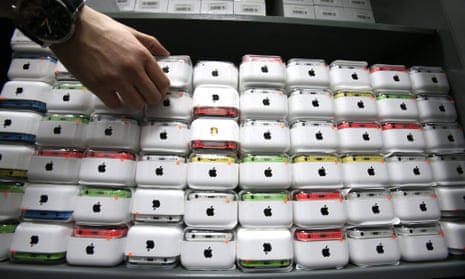Apple's executives expressed concern in April 2013 that “consumers want what we don’t have” in smartphones – specifically, larger screens or significantly cheaper phones – according to documents released in its patent trial with Samsung in California.
But separate rumours from supply chain sources quoted by Reuters suggest that the company plans to introduce a larger-screen phone this year as the high end of the smartphone market slows down.
A presentation from Apple’s planning meeting for the 2014 fiscal year, which runs from September 2013 to September 2014, shows that it was already focusing on the slowdown in the top-end smartphone market for smaller screens such as the iPhone.
Other internal Apple documents admitted as evidence by Samsung also show that the company was considering creating a low-cost iPhone based on the iPod Touch as far back as autumn 2010, to replace its then year-old iPhone 3GS.
A series of slides admitted as evidence in the Apple-Samsung trial being held in San Jose shows the growth in the smartphone market between 2011 and 2012. The slides show that of the 228m extra devices sold – up from 494m to 722m in 2012 – 91m were priced at more than $300 (£180) with a screen more than 4in diagonally; 159m were priced at less than $300; and there was a drop of 22m in sales of “everything else” – that is, phones priced over $300 but with screens of 4in or less, which includes all Apple’s present iPhone range.
This article includes content provided by Scribd. We ask for your permission before anything is loaded, as they may be using cookies and other technologies. To view this content, click 'Allow and continue'.
Apple falls squarely into the “everything else” range. Although it upped the screen size of the iPhone in September 2012, introducing the iPhone 5 with a 4in screen rather than the 3.5in screen of the previous generations, the data from its internal presentation shows that executives are aware of the gap between its high-priced phones and the growing trend towards larger screens over 4in, spearheaded by products from companies including Samsung.
Decelerating growth
The company’s internal presentation shows that the executives recognised that its own phone sales were seeing rapidly decelerating growth.
However, new phones typically have a lead time of up to two years because of the time required to acquire factory capacity and prove prototypes.
The presentation notes: “Competitors have drastically improved their hardware and in some cases their ecosystems,” and asserts that some rivals are “spending ‘obscene’ amounts of money on advertising and/or carrier/channel to gain traction”.
Samsung is presenting the documents in its defence against Apple, which is seeking $2bn in damages from the South Korean manufacturer, alleging that it infringed a number of iPhone-related patents and that this helped it gain sales at Apple’s expense.
Samsung counters that the evidence from Apple’s own internal documents points to other causes for its success and Apple’s slowing sales, not any alleged use of the patented technology – whose validity is also being questioned.
Apple’s concern about the changing dynamics of the smartphone market seems to have been expressed as far back as late 2010, according to other documents released in the trial. Those show that Apple considered building a “low-end iPhone” based on the iPod Touch to replace the 3GS model from autumn 2011.
The cheaper iPhone 5C, released along with the high-end iPhone 5S in September 2013, may be Apple’s form of low-end iPhone – although its unsubsidised price of $450 suggests that the company chose not to compete on price, despite the growth of that market segment.
Research forecasts reckon that the high-end smartphone market will be stagnant at best in 2014, with the majority of growth coming from the sub-$300 market.
Waving a wand
The company's executives also met in early 2011 and considered whether to add a “wand” to the Apple TV set-top box, as it prepared to make 2011 the year of a “holy war” with Google.
An email sent by Steve Jobs in October 2010 – a few months after the release of the iPhone 4, and with the next-generation iPhone 4S still a year away – gives an insight into Apple’s then-unfolding strategy as the company prepared for its “top 100” meeting of top-level executives in which new products for the forthcoming year, and even phones from two years ahead, were to be discussed.
The document has been released to Samsung as part of the legal discovery process, under which internal documents that could bolster its case can be presented as evidence in court.
The strategy meeting shows that Apple had mapped out its smartphone plans at least two years ahead. The iPhone 4S and its Siri voice assistant are both referred to in the email – as is the iPhone 5, then just under two years away from being launched.
Reuters reports though that Apple has begun testing of a larger 4.7in screen which could begin production as early as May.
This article includes content provided by Scribd. We ask for your permission before anything is loaded, as they may be using cookies and other technologies. To view this content, click 'Allow and continue'.

Comments (…)
Sign in or create your Guardian account to join the discussion